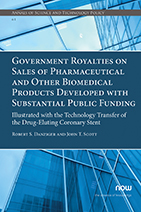Government Royalties on Sales of Pharmaceutical and Other Biomedical Products Developed with Substantial Public Funding: Illustrated with the Technology Transfer of the Drug-Eluting Coronary Stent
By Robert S. Danziger, Professor of Medicine, Pharmacology, Physiology and Biophysics, University of Illinois at Chicago, USA, rdanzig@uic.edu | John T. Scott, Professor of Economics, Emeritus, Dartmouth College, USA, john.t.scott@dartmouth.edu
Abstract
This study develops a detailed description of the successful technology transfer of an invention—the drug-eluting coronary stent—originating in intramural research within the National Institutes of Health. The history of the commercialization of the invention is used to illustrate a new policy, proposed and explained in this study, for the payment to the government of royalties on the sales of biomedical products developed with substantial public funding provided through indirect as well as direct funding avenues. The proposed policy addresses concerns about the high prices that taxpayers as consumers pay for biomedical products that were developed with funding from the taxpayers as investors. The study explains the theoretical circumstances in which the policy would not adversely affect the appropriate level of R&D investment, and then uses the history of the drug-eluting coronary stent as an example where biomedical R&D is consistent with those circumstances.
Government Royalties on Sales of Pharmaceutical and Other Biomedical Products Developed with Substantial Public Funding: Illustrated with the Technology Transfer of the Drug-Eluting Coronary Stent
This study develops a detailed description of the successful technology transfer of an invention — the drug-eluting coronary stent — originating in intramural research within the US National Institutes of Health. The history of the commercialization of the invention is used to illustrate a new policy, proposed and explained in this study, for the payment to the government of royalties on the sales of biomedical products developed with substantial public funding provided through indirect as well as direct funding avenues. The proposed policy addresses concerns about the high prices that taxpayers as consumers pay for biomedical products that were developed with funding from the taxpayers as investors. The study explains the theoretical circumstances in which the policy would not adversely affect the appropriate level of R&D investment, and then uses the history of the drug-eluting coronary stent as an example where biomedical R&D is consistent with those circumstances.
